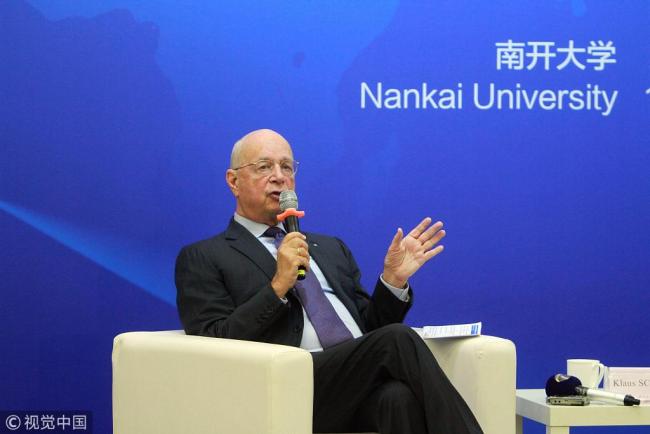Stories of the China Reform Friendship Medal recipients
3. Klaus Schwab

World Economic Forum (WEF) Executive Chair and founder Klaus Schwab addressing students in Nankai University in Tianjin, September 18th, 2018. [Photo: VCG]
Professor Klaus Schwab is an engineer and economist. But he is best known as the Founder and Executive Chair of the World Economic Forum and the International Organization for Public-Private Cooperation.
He founded the Forum in 1971. Schwab paid his first visit to China in 1979 and later invited a Chinese delegation to Davos. China had just launched its reform and opening-up policy in 1978. Over the next 30 years, Schwab visited China at least once a year. China began establishing closer and closer cooperation with the World Economic Forum, eventually leading to the establishment of the so-called "summer Davos" in China on an annual basis in 2007.
The Forum employs over 700 people, with its headquarters in Geneva, Switzerland. The WEF also maintains additional offices in New York, San Francisco, Beijing and Tokyo. In 2007, the foundation established the Annual Meeting of the New Champions - Summer Davos - which is held annually between the cities of Dalian and Tianjin on a rotating basis.
4. Konosuke Matsushita

Konosuke Matsushita in Japan, January 31, 1975. [File photo: VCG]
Kōnosuke Matsushita founded Panasonic, the largest Japanese consumer electronics company. He passed away at the age of 94 in 1989.
In October 1978, then-Vice Premier Deng Xiaoping travelled to Japan to sign the Japan-China Peace and Friendship Treaty, where he met with Kōnosuke Matsushita and asked him if he was willing to help China advance the modernization.
Kōnosuke Matsushita accepted an invitation from Deng and visited China in 1979. Later he came up with a plan to establish a joint venture. Beijing Matsushita Color CRT Co., Ltd. (BMCC) was established as the first joint venture in China in 1987. There were 250 Chinese employees selected to be on the first production line. They received practical training in Japan for six months prior to the start of production.
In June 1989, the first locally-produced CRT units were completed in Beijing.
The joint venture was albe to turn a profit in its first year. Other Japanese companies began to follow Panasonic's lead. Matsushita's initial vision in Beijing eventually led to the establishment of 79 factories across China employing nearly 60,000 people.

